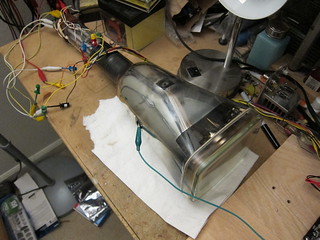P10 Dark Trace CRT – The Skiatron
June 9, 2014 7:35 pm UncategorizedI have a little story to tell. Years ago, I met someone who had a very large collection of CRTs. He had everything from common 3BP1s all the way to rare little gems like the 1EP1 and some vintage prototype CRTs. He showed me an item in his collection which was a rectangular CRT with a P10 phosphor. Finding a CRT with the P10 phosphor is like finding a unicorn. P10 is not really a phosphor; it designates a screen coated with some sort of alkali-halide (potassium chloride) that darkens when hit with an electron beam–a scotophor. The darkening effect lasts until the coating is heated, and typical P10 CRTs have a built-in heater that erases whatever was recorded on the screen.
Anyway, a few years go by and I lose contact with the guy. Rumors are flying around, and it turns out that he has decided to sell his entire collection. Bits and pieces of it start showing up at auction houses and flea markets. Another friend of mine mentions that he picked up a lot of CRTs at an auction house and asked if I wanted to pick through it. While sorting through it, I recognized the rare beast and bought it on the spot.
So I finally got the time to hook it up and try it out. There doesn’t seem to be any documentation. The part number is 06E024P10, made by Thomas Electronics. It works, but not particularly well. Since the pin connections are nonstandard and the electron gun has some extra elements, I’ve probably got it connected all wrong. Anyway, I was able to put some scribbles on the screen.
Notice the dark purple areas. I am shining a lamp through an aperture in the top of the CRT.
Looking through the aperture, you can see how the CRT has a standard green phosphor section on the top third. This might have been used to verify that the tube’s electron gun was in focus. It could also have been used for status information. Most likely this tube would have been used in an early form of storage oscilloscope for capturing single-shot high speed events, although most examples of P10 tubes were designed for radar displays.




Vladimir :
Date: June 16, 2014 @ 11:44 am
Dear sir!
If you are going to suddenly sell this CRT, let me be the first in line for it. Name the only price.
Mark :
Date: April 1, 2015 @ 7:43 pm
Hello,
This is a great demo of this tube. Can you provide more detail on how you connected it? I have a 4AP10 that I would like to connect and see if I can get anything out of it. Here is the spec sheet http://frank.pocnet.net/sheets/201/4/4AP10.pdf
Which interestingly enough, include details on winding the required deflection coils.
Looks like it needs ~9kv acceleration voltage.
eric :
Date: May 14, 2015 @ 4:23 pm
Nice find, Mark!
The acceleration voltage is +9KV (relative to the cathode) at 100uA-1000uA beam current which is pretty high power! The datasheet mentions forced air cooling. If you’re just running it for a short time it will probably be OK without it. I’d try running it at a lower anode voltage (maybe 5KV at first) and play it safe.
You’ll need to wire the filament to a 6.3V filament transformer. The cathode goes to ground. The grid can be tied to ground but you probably want to connect it to a negative adjustable supply to vary the brightness (-10V seems like a good starting point). The datasheet gives the cutoff voltage at -45V which is the voltage at which the beam turns off completely.
There is a second grid for acceleration purposes that needs 300V. You could have a resistor divider to step the 9KV down to 300 but the resistors will need to be able to handle the voltage (not your ordinary parts box resistor).
The hardest part will be the focus coil assembly, unless you already have one. They’re hard to find, so you will probably have to fabricate one. I have not built one yet but the directions in your linked datasheet are pretty clear. If you try to use the tube without a focus coil I don’t think you’ll see anything. The datasheet mentions using a defocused beam as a way of erasing the screen.